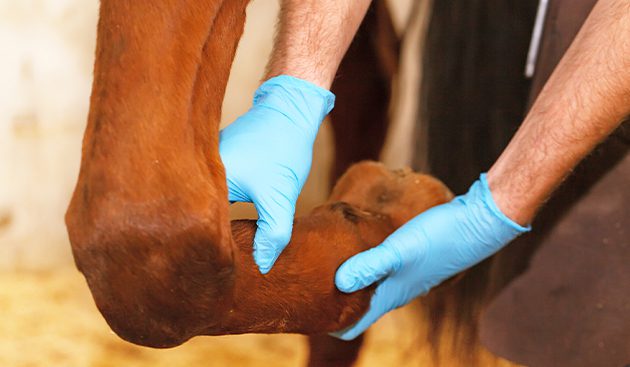Latest Blogs
Treating Lameness of the Equine Foot
Lameness is a common clinical presentation in horses, the National Equine Health Survey in 2018 reported that lameness as a syndrome affected 29% of horses, with foot lameness (excluding laminitis) recorded in 5.4% of all syndromes reported.
Lameness of the foot is by far the most common cause of unsoundness in the horse.
Common signs of lameness
Common signs to look out for that may suggest the lameness is originating from the foot:
- Heat in the foot that may be localised or diffuse across the hoof wall and coronary band.
- An increased digital pulse (felt at the back of the fetlock or pastern).
- Swelling extending above the foot to the pastern, fetlock and cannon regions.
The severity of lameness is variable depending on the cause.
- A severe lameness with reluctance to bear weight may be caused by a foot abscess ‘gravel’ – this is generally accompanied by a strong digital pulse, heat in the foot and sensitivity on hoof testers. If a foot abscess is suspected seek advice from your veterinarian and farrier.
- Other causes of severe lameness originating from the foot include sepsis, fracture and laminitis.
- Problems causing subtle and more variable lameness of the foot include – solar bruising, thrush, white line disease, hoof cracks, keratoma, osteoarthritis of the coffin joint, navicular syndrome, collateral/sesamoidean ligament desmopathy and deep digital flexor tendonitis.
Further diagnostics for foot lameness
To localise or confirm a foot lameness a nerve block may be used – a palmar digital nerve and abaxial sesamoid nerve block. A local block of the coffin joint or navicular bursae may also be helpful. However, it should always be remembered that the local anaesthetic used will diffuse away from the injection site immediately which can reduce the specificity of this technique for pain localisation.
Further diagnostic imaging may be necessary – radiography (x-ray) is very useful for identifying a fracture, osteoarthritis, pedal osteitis, navicular syndrome, pedal bone rotation and penetrating wounds.
by Dr Charlotte Inness BVSC MRCVS
About Charlotte Inness (www.thehorsevet.co.uk)
Charlotte qualified as a veterinary surgeon from the University of Liverpool then worked in Australia, Hong Kong, Staffordshire and finally Yorkshire as an Equine Veterinarian. During this time she has worked with all types of horses from racehorses, brood mares, foals, competition horses and companions. Always having an interest in lameness and poor performance, Chiropractic was appealing as another skill to aid lameness work up and diagnosis.
Having carried out further training in Germany at the International Academy of Veterinary Chiropractic she decided to incorporate chiropractic more prominently in her veterinary work.
The Horse Vet was established in 2015 to provide a service to treat poor performance in horses, focussing on the musculoskeletal system, using a combination of traditional veterinary medicine, equine chiropractic, equine acupuncture (traditional Chinese and Western approach) and state of the art gait analysis technology.
